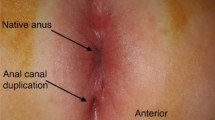Abstract
Anal canal duplication (ACD) represents an extremely rare intestinal congenital anomaly of unknown origin. Usually evidenced within 2 years of age, nearly 45% of reported cases present associated malformations such as presacral mass, anorectal malformation (ARM) and genitourinary anomalies. The confirmative diagnosis is istopathological, with evidence of an anal mucosal lining (squamous ± transitional epithelium), surrounded from a smooth muscle coat and anal glands. We review a conjoined experience from two European pediatric surgical departments. From 1970 to 2005, 12 patients were observed, seven in Pescara, Italy (1997–2005), five in Barcelona, Spain (1970–2004)—mean age at diagnosis 17.8 months, range 0–60; M:F = 1:11. Clinical presentation, diagnostic-surgical approach, and complications were reviewed. According to clinical presentation, patients could be divided in three age groups: asymptomatic (mean age 4.8 months, six patients—one with an associated complex genitourinary malformation, one with a presacral mature teratoma, one with ACD evidenced hysthologically on a retroanal mass removed during the correction of an ARM), mildly symptomatic—constipation, mucous discharge (mean age 29.2 months, four patients—one with associated presacral ependymoma and intestinal neuronal dysplasia type B, one with presacral mass) and complicated—perineal abscess, recurrent fistula (mean age 34 months, two patients). In 11 cases a perianal orifice was evident (ten posteriorly located). The pelvic-MRI was the preferred diagnostic tool in Pescara (5/7, with presacral mass in two patients), fistulography in Barcelona (5/5), where one presacral mass was discovered intraoperatively. Eleven patients underwent surgical removal of the ACD (five perineal approach, five posterior sagittal approach, and one PSARP). Histopathological findings confirmed the diagnosis in operated cases (11). The parents of the male patient denied the consent to surgical treatment. The only major post-operative complication was a sphincteric insufficiency (one case), surgically treated. When facing a perianal orifice, attention should be paid to ACD, particularly in female patients with coexistent genitourinary or intestinal malformations. Pelvic US and MRI are the gold standard to evidence the not rarely associated presacral mass. Surgical early removal (mucosectomy or perineal/posterior sagittal approach, depending on length of ACD and associated presacral mass) is warranted, also in asymptomatic patients, because of the risk of inflammatory complications and cancer (the latter reported in literature in adults).




Similar content being viewed by others
References
Gross RE, Holcomb GW, Farber S (1952) Duplication of the alimentary tract. Pediatrics 9:449
Abrami G, Dennison W (1960) Duplication of the stomach. Surgery 49:794–801
Aaranson I (1970) Anterior sacral meningocele, anal canal duplication cyst and covered anus occurring in one family. J Pediatr Surg 5:559–563
Tagart REB (1977) Congenital anal duplication: a cause of para-anal sinus. Br J Surg 64:525–528
Hata Y, Sato K, Ikeda Y, et al (1978) Duplication of the rectum and/or anal canal. J Jpn Soc Pediatr Surg 14:105–109
Ogawa T, Hasegawa S, Hirai Y, et al (1984) A neonatal case of anal duplication associated with congenital anal stenosis. Jpn J Pediatr Surg 16:237–241
Yatsuzuka S, Okamatsu T, Ishikawa M (1986) A case with Currarino’s triad. Jpn J Pediatr Surg 18:1627–1638
Arai T, Miyano T, Tanno M, et al (1990) Tubular anal duplication—experience with two cases. Z Kinderchir 45:311–313
Adachi Y, Akiyama H, Takamatsu H, et al (1991) A case of anal canal duplication. J Jpn Soc Pediatr Surg 27:1241
Ishikawa M, Watarai Y (1994) A case of anal canal duplication. Jpn J Pediatr Surg 30:1343–1347
Hamada Y, Sato M, Hioki K (1996) Anal canal duplication in childhood. Pediatr Surg Int 11:577–579
Becmeur F, Ait Ali Sliman M, Chevalier-Kauffmann I, et al (1998) Duplication du canal anal chez l’enfant. 55° Congrès de Chirurgie Pediatrique (oral presentation), Paris
Jacquier C, Dobremez E, Piolat C, et al (2001) Anal canal duplication in infants and children—a series of 6 cases. Eur J Pediatr Surg 11:186–191
Ponson AE, Festen C (2001) Postanal sinus: single or different etiologies? Pediatr Surg Int 17:45–47
Ochiai K, Umeda T, Murahashi O, et al (2002) Anal-canal duplication in a 6-year-old child. Pediatr Surg Int 18:195–197
Choi SO, Park WH (2003) Anal canal duplication in infants. J Pediatr Surg 38:708–712
Tiryaki T, Şenel E, Atayurt H (2006) Anal canal duplication in children: a new technique. Pediatr Surg Int 22:560–561
Dukes CE, Galvin C (1956) Colloid carcinoma arising within fistula in the anorectal region. Ann R Coll Surg Engl 18:246–261
Azmy AF (1990) Complete duplication of the hindgut and lower urinary tract with diphallus. J Pediatr Surg 25(6):647–649
van der Putte SCJ (1986) Normal and abnormal development of the anorectum. J Pediatr Surg 21:434–440
Nievelstein RAJ, van der Werff JFA, Verbbeek FJ, et al (1998) Normal and abnormal embryonic development of the anorectum in human embryos. Teratology 57:70–78
Author information
Authors and Affiliations
Corresponding author
Rights and permissions
About this article
Cite this article
Lisi, G., Illiceto, M.T., Rossi, C. et al. Anal canal duplication: a retrospective analysis of 12 cases from two European pediatric surgical departments. Pediatr Surg Int 22, 967–973 (2006). https://doi.org/10.1007/s00383-006-1801-x
Published:
Issue Date:
DOI: https://doi.org/10.1007/s00383-006-1801-x




